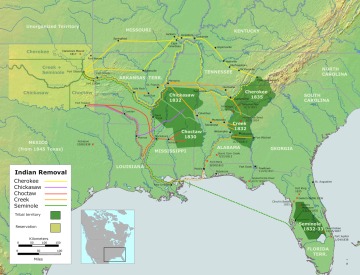1838: Cherokee die on Trail of Tears
The U.S. Department of War forcibly removes approximately 17,000 Cherokee to Indian Territory (which is now known as Oklahoma). Cherokee authorities estimate that 6,000 men, women, and children die on the 1,200-mile march called the Trail of Tears. Other Cherokee escape to North Carolina, where they elude capture and forced removal. Their descendents remain in their homeland in the Great Smoky Mountains to this day. Many tribes in the Southeast, the Northeast, and Great Plains have their own trails of tears.
The Trail of Tears is the name of the Cherokee’s forced removal by the U.S. to Indian Territory. But the phrase is also applied to the forced removals of the Chickasaw, Choctaw, Muscogee Creek, and Seminole, who were all removed from the Southeast. Sometimes the phrase is also applied to other forced removals of tribes elsewhere in the country.
- Theme
- Federal-Tribal Relations, Land and Water
- Region
- Great Plains, Southeast
Map showing the Cherokee Trail of Tears and other forced relocation marches.
During the 1830s the U.S. government forced tens of thousands of Native Americans, including many members of the Cherokee, Muscogee Creek, Seminole, and Choctaw nations from their homelands to Indian Territory (present day Oklahoma). The phrase “Trail of Tears” originated from a description of the removal of the Choctaw Nation in 1831.
